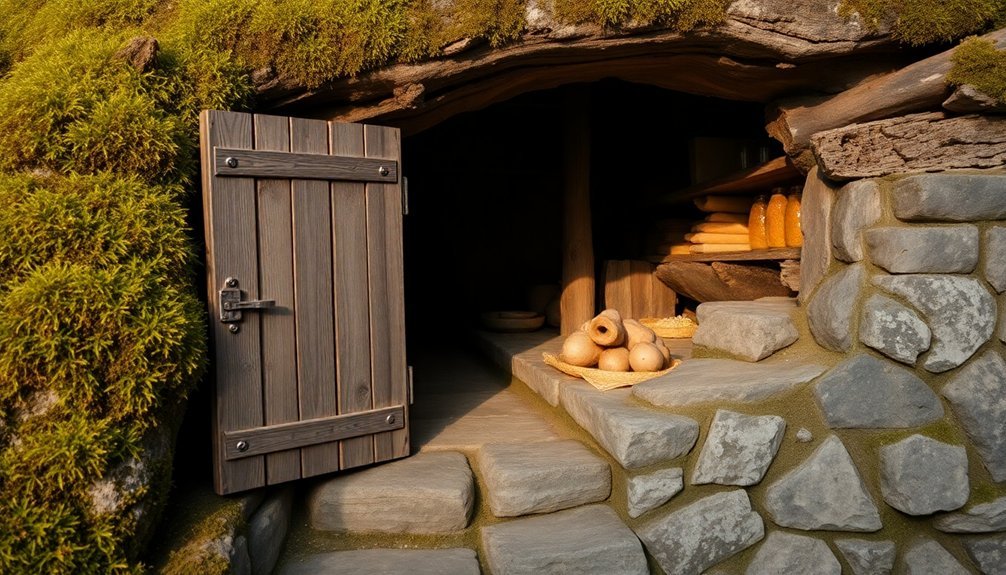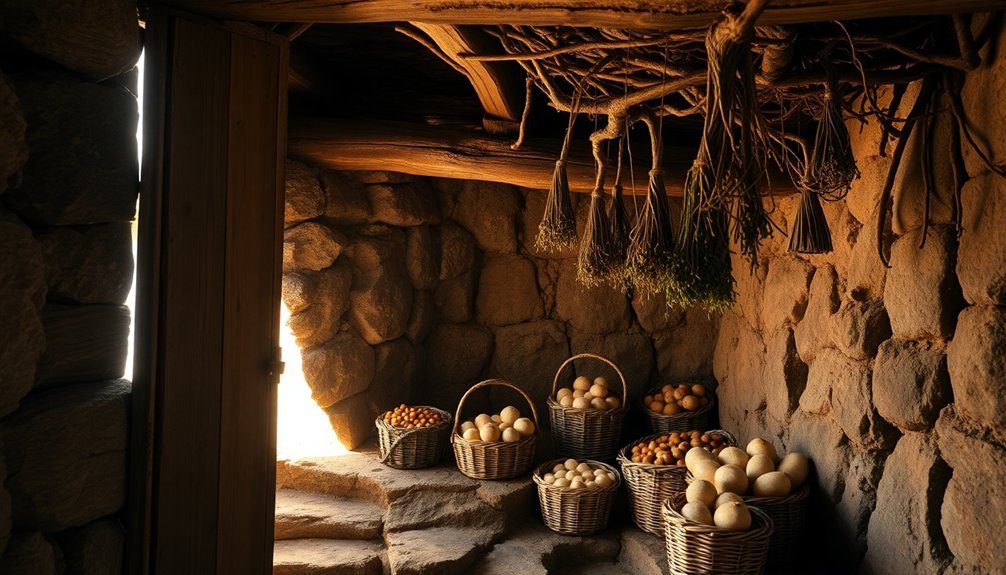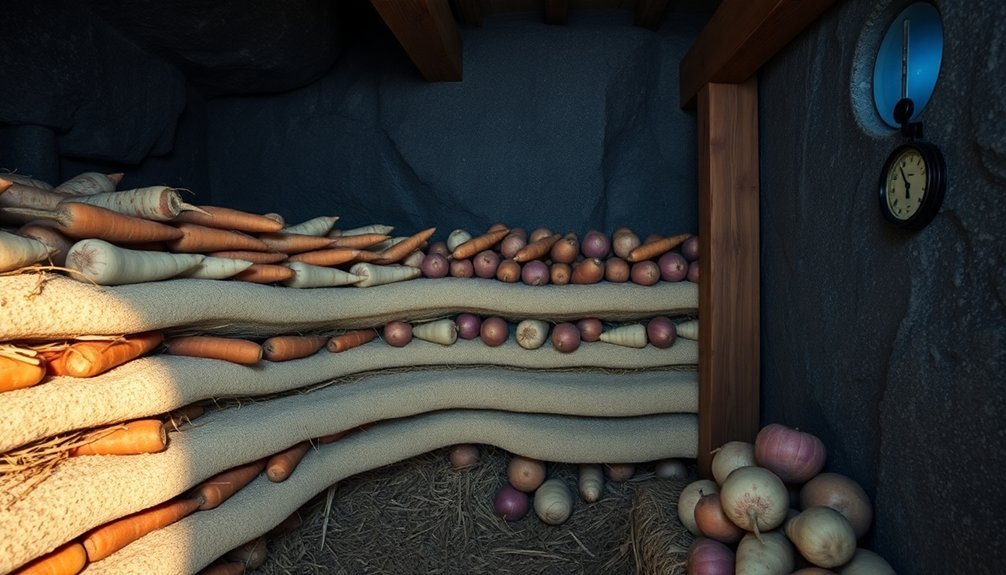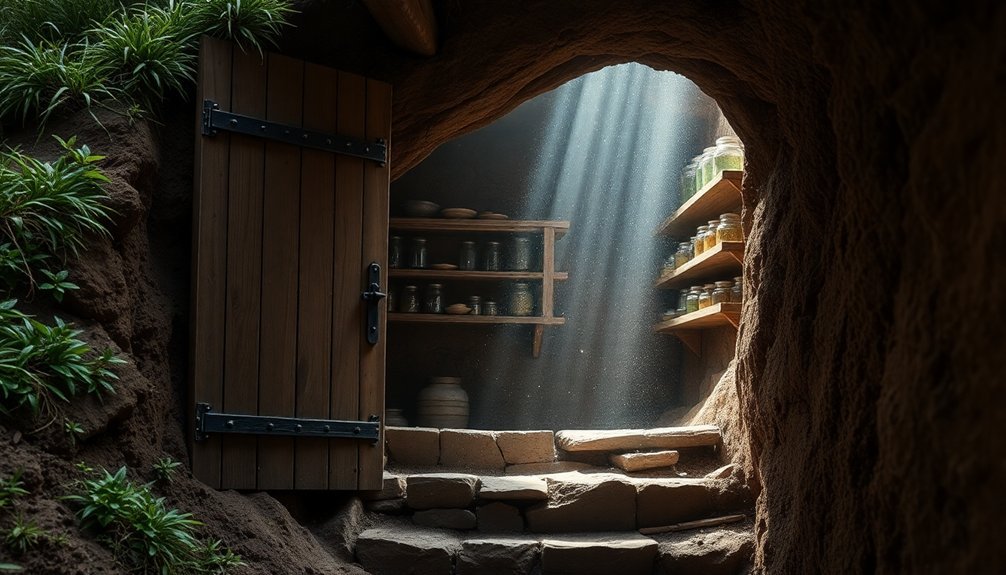Nordic root cellars offer you a proven underground storage solution that's stood the test of time for over 5,000 years. You'll need to start with a properly insulated earth pit, using 2-inch rigid insulation sheets and 2-4 feet of soil cover. Keep the temperature between 32-40°F and humidity at 85-95% for ideal preservation. Layer your vegetables with moist soil, maintaining 2-inch gaps for air circulation, and guarantee proper drainage. Before stocking, clean thoroughly and organize distinct zones for different produce types. These ancient techniques hold many more secrets to keeping your harvest fresh year-round.
Ancient Nordic Storage Wisdom

Nestled beneath an ancient Neolithic house in Denmark, a remarkable 5,000-year-old root cellar reveals the ingenious food preservation techniques of our ancestors.
You'll find this architectural marvel at Nygårdsvej 3, where archaeologists uncovered a carefully designed storage space measuring 2 by 1.5 meters, with a distinctive trapezoid shape and 40 cm depth. This discovery was made during railway construction work, bringing this ancient treasure to light.
The cellar's construction shows you how the Funnel Beaker Culture mastered early engineering. They selected and placed stones with precision, creating a paved floor that's withstood millennia.
The design wasn't random – they built it to maximize food preservation during harsh Nordic winters.
What you're seeing isn't just a simple hole in the ground. It's evidence of a sophisticated agricultural society that understood the principles of thermal regulation.
They chose their location strategically, often building into hillsides or glacial moraines for natural insulation. By creating this underground storage system, these early farmers transformed their community's ability to survive year-round.
The discovery challenges everything you might've assumed about Neolithic capabilities, proving they possessed advanced technological knowledge and organizational skills.
Earth Pit Design Essentials
- Install rigid 2-inch insulation sheets covered with 6-mil polyethylene on the roof.
- Add 2-4 feet of soil on top and plant grass to prevent erosion.
- Leave 2-inch gaps between shelves and walls for air circulation. Walk-in cooler door provides convenient access while maintaining temperature control.
Remember to make your entrance accessible for loading and unloading, and guarantee proper drainage around the cellar to prevent water damage.
Keep shelves relatively shallow, around 16 inches deep, and brace them well for structural integrity.
Natural Insulation Methods

Beyond modern synthetic materials, traditional Nordic root cellars rely heavily on natural insulation methods that have proven effective for centuries. You'll find that earth itself serves as your primary insulator, with soil maintaining consistently cool temperatures at depths of 6 feet or more.
By covering your cellar's roof with 2-4 feet of soil and planting grass on top, you'll prevent erosion while enhancing insulation benefits. These methods help achieve optimal storage temperatures between 32-40°F (0-4°C).
For interior insulation, you can line your walls and ceiling with straw bales or sawdust, both excellent natural insulators. Wood shavings work particularly well for root boxes, while earth and clay provide additional insulation due to their poor heat conductivity.
Don't forget to maintain proper air circulation by leaving gaps between your shelves and walls.
You'll need to protect your natural insulation materials by guaranteeing proper drainage. Add a layer of gravel on the floor to prevent water buildup, and install adequate ventilation near the ceiling.
To maintain ideal humidity levels, you can use damp burlap or moistened sawdust. When backfilling around your cellar walls, guarantee proper compaction to enhance the earth's insulating properties.
Seasonal Preparation Steps
When preparing your Nordic root cellar for the changing seasons, timing and thoroughness are essential for success. You'll want to wait until late in the growing season, just before the first hard frost, to begin stocking your cellar. This guarantees your produce is harvested at peak freshness and will store longer during the winter months.
Before storing any items, you'll need to check and adjust your cellar's environmental conditions. Install thermometers and hygrometers to monitor temperature and humidity levels, aiming for 32-40°F and 85-95% humidity. Confirm your ventilation system is working properly to prevent ethylene gas buildup and maintain consistent air circulation.
- Clean and sanitize all storage areas, removing any debris or remnants from previous seasons.
- Test ventilation systems and install any necessary fans or vents.
- Add fresh dirt or gravel to the floor to help maintain proper humidity levels.
Remember to organize your storage space by creating distinct zones for different produce types, as each variety may require slightly different conditions.
Position items that need checking more frequently near the entrance, and arrange shelving to maximize air flow around stored goods.
Root Vegetable Layering Techniques

Proper layering techniques form the foundation of successful root vegetable storage in Nordic cellars. You'll want to start with a base layer of slightly moist soil at the bottom of your storage container or earth pit. Place your prepared root vegetables on top, ensuring they don't touch each other, then cover them with about an inch of soil.
| Layer Component | Purpose |
|---|---|
| Bottom Soil | Creates moisture barrier and base support |
| Root Vegetables | Main storage items, spaced for airflow |
| Middle Soil | Maintains humidity and prevents contact |
| Top Soil/Straw | Provides insulation and moisture control |
Continue alternating vegetables and soil until your container is about two-thirds full. For the final layer, add 3-4 inches of soil to lock in moisture. If you're using an underground pit, incorporate straw or leaves between layers for extra insulation. Make sure you've trimmed the vegetable tops to within an inch, leaving the root crown intact to prevent decay.
You can also use alternative materials like wood shavings or sand in containers, which offer excellent moisture control and antimicrobial properties. Whatever method you choose, maintain consistent moisture levels throughout the layers – they should feel like spring garden soil.
Frequently Asked Questions
How Do You Prevent Rodents From Entering Nordic Earth Pit Storage Cellars?
You'll need to seal all entry points with hardware cloth and mortar, maintain strict cleanliness, use mint repellents, and set traps strategically. Don't forget to store food in airtight containers and eliminate water sources.
Can Traditional Nordic Cellars Be Adapted for Modern Suburban Homes?
You can adapt traditional cellars for your suburban home by converting basement spaces, adding ventilation windows, and installing proper moisture barriers. Consider building into existing hillsides or incorporating storage beneath garages.
What Emergency Backup Systems Work During Power Outages Affecting Ventilation Equipment?
You'll maintain airflow during power outages using gravity-fed backup vents, manual damper controls, and battery-operated fans. Simple hand-cranked ventilators and passive air channels can also keep your storage space properly ventilated.
How Do Different Soil Types Affect Earth Pit Storage Temperature Regulation?
You'll find clay soils provide better temperature stability due to their density, while sandy soils offer less insulation. Loamy soils give you moderate regulation, and moisture content in any soil enhances temperature control.
When Is the Best Time to Harvest Vegetables for Nordic Pit Storage?
You'll want to harvest your root vegetables after the first light frost but before the ground freezes. That's when they're sweetest and most storage-ready, typically in late fall around October.
In Summary
Now you're equipped with the ancient Nordic wisdom of earth pit storage. You'll find these traditional methods surprisingly effective for keeping your root vegetables fresh through winter. By following proper design, insulation, and layering techniques, you've gained a sustainable way to preserve your harvest without modern technology. Put these earth pit storage practices to work, and you'll enjoy garden-fresh produce even in the coldest months.





Leave a Reply